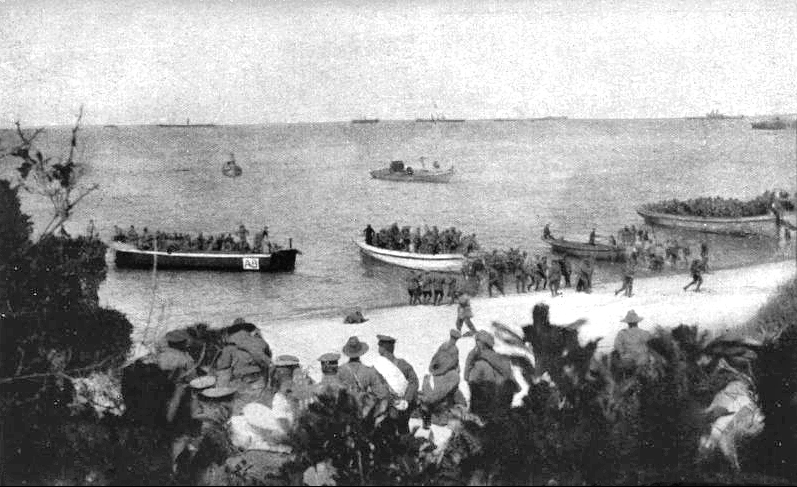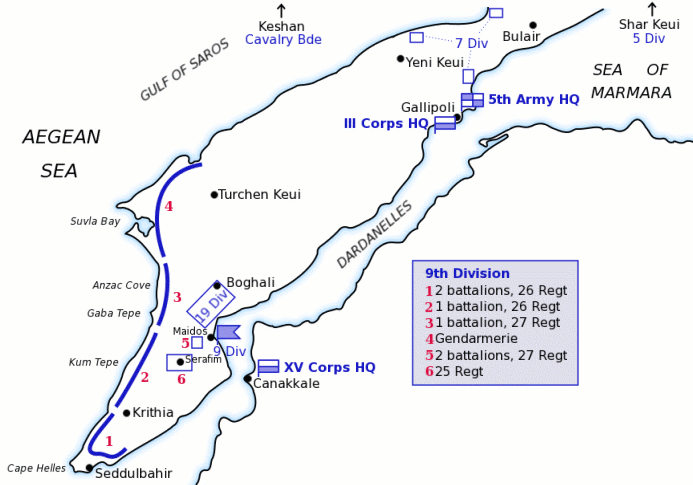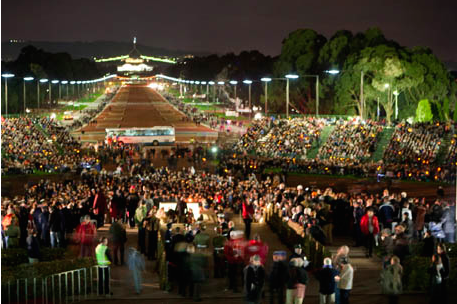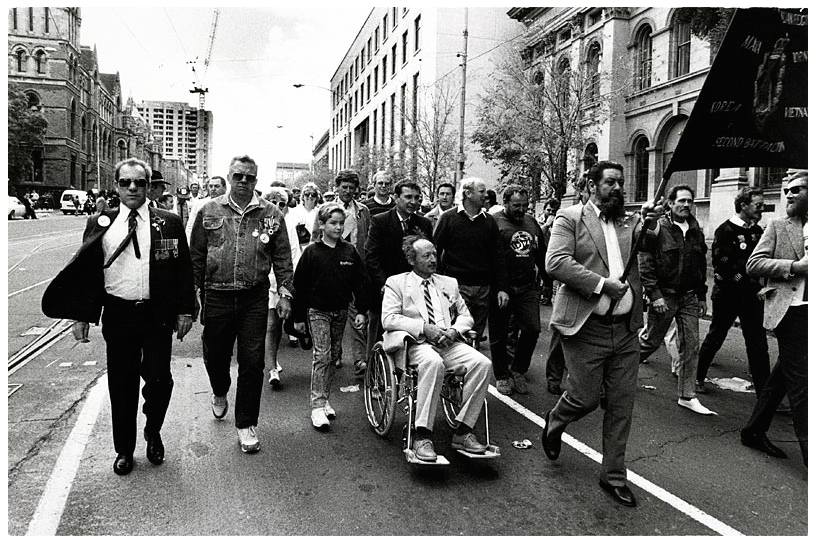What is the future of the RSL? Half the current members are WWII veterans and the great majority of these will be gone in five years. So while the RSL still looks robust, Steve Irons questions whether its future is so rosy.
In the middle of the First World War in 1916, a large demonstration in London including a march of 2,000 ANZAC soldiers expressed a genuine outpouring of grief, marking the first anniversary of the disaster in Gallipoli in Turkey. The date was 25 April,1916 and this was the first “Anzac Day”. The march by Australian and New Zealand troops was the centrepiece of a wide variety of ceremonies.
The attempt by the Anzacs to invade the Ottoman Empire was a strategic mistake by the British military and was the biggest disaster in Australian military history.
Australian 4th Battalion troops landing in Anzac Cove, 25 April 1915.
This march in London gave rise to similar regular annual “Anzac Day” events in Australia for the next 100 years. These annual events became the focus of the most powerful organisation in Australia’s history, the Returned Servicemen’s League, or just simply “the RSL”.
As people prepare for a “special Anzac Day celebration” this week, marking 100 years since that initial disaster, few realise that in 2015 we have reached a breaching point, a point of no return, for Anzac Day celebrations. The sun is setting. The RSL is about to enter a new era in which there will soon be no member of the RSL who has had any experience of any “world war”, and this will have a dramatic impact on Australian social life.
The toll
The attempt by the Anzacs to invade the Ottoman Empire at Suvla Bay on the Gallipoli Peninsula on 25 April 1915, was a diversionary tactic to shift focus away from the real invasion by the British forces, which also failed, and is well understood to be a strategic mistake by the British military.
Twenty thousand Anzacs were involved in the initial invasion and it was an immediate failure. The Anzacs were told to "hang in there" which they did for eight months but were no match for the Turks. Of the Australian casualties at Gallipoli, 8,709 “diggers” lost their lives, including 664 Australian officers, 17,260 men were wounded and 70 captured.
Dispositions of the Ottoman Fifth Army
This was the biggest disaster in Australian military history.
While the Gallipoli disaster was huge for Australia, it hardly registered a blip with the British, who were occupied with the larger overall operation in the Dardanelles. The Australian military establishment in London, humiliated by this defeat, had little option but to show support for the demonstration in London. Anzacs were from the colony and were considered expendable.
It was said that Prime Minister “Billy” Hughes attended the demonstration in London but he might not have. Accounts of his visit don't mention it. Hughes was there to argue for introduction of conscription because he was afraid of the Japanese entering WWI on the wrong side and the "Yellow Peril" that would be for Australia.
Initial responses
There are many different accounts of the beginnings of ANZAC Day “celebrations” in Australia. It seems most likely that first Anzac Day celebrations occurred unofficially in 1916 at churches around the nation, before being officially recognised as a national public holiday in 1923.
There are also accounts of spontaneous "marches" from 1916 onwards, like returned wounded diggers marching from the Domain to Macquarie Street to be saluted by the Governor or being wheeled in their wheelchairs from the Sydney hospital in Macquarie Street with nurses in tow.
The first "services" were religious services by the Church of England, who had a real need to back up their British imperial interests and claim that “God knows what is right”.
Later a separate "service" was introduced removing any particular faith, as it became a place for all returned "diggers" and the families of the fallen (becoming the “Dawn Service” of later years) and “remembering our sons and our brothers”.
The linking of these two formats, the "service" and the "march" became the norm that dominated the Australian political scene for the next 90 or so years.
Anzac Day Dawn Service at the Australian War Memorial in Canberra. http://www.army.gov.au/Our-history/Traditions/Dawn-Service
The Gallipoli "legend"
Anyone who is anyone will tell you that Australia “came of age” as an independent and proud nation at Gallipoli, but they won’t tell you why — why a complete failure makes us proud to be Australian. It usually goes something like this, according to the chapter, 'Our History' on the Army's website:
‘Gallipoli became the common tie forged in adversity that bound the colonies and people of Australia into a nation.’
It seemed to start out as a dumb (and quite offensive if you think about it) statement by the Australian command in the face of the huge losses that they (the Army) were
‘anyway proud that this was the first time they got to command their own forces on the ground.’
But for families trying to find something to hang their son’s helmet on, it received some positive public resonance — enough for the Army to seize the opportunity. And so a legend was born.
Returned Servicemen's League
With these spontaneous demonstrations occurring, in 1916, the Returned Servicemen’s League (RSL) was formed to try to minimise the impact of this disaster on the recruitment drive. This involved organising care for the huge amount of wounded on their return and make sure their sickness, failure to heal, loss of limbs and general widespread depression, and often lunacy, didn’t obstruct future recruitment.
First World War - half a million recruits
Around 420,000 Australians enlisted for service in the First World War, representing 38.7 per cent of the male population aged between 18 and 44. For the newly formed RSL, this was an amazing recruitment ground.
After just four years of engagement, 270,000 servicemen (and women) were returning from a nasty war, in need of assistance, 155,000 of whom had been wounded, 3,600 of whom had been POWs. And another 87,000 volunteered but didn't get to serve overseas.
The Australian Bureau of Statistics (ABS) provides a useful overlay to Australia’s engagements.
On the basis of these numbers, the RSL was able to build the most powerful non-government organisation in Australia's history.
Second World War - a million recruits
It wasn't long before the RSL was again called on fulfil their special role. Another nasty war broke out in Europe with the Nazis looking to take over the world. Australia sent troops to Europe and later to play a special role in South East Asia fighting the Japanese. Prime Minister Billy Hughes was finally vindicated in his racist fears of the "Yellow Peril". His conscription plan was finally introduced to create a Citizen's Military Forces (CMF) who were treated as a bit of a joke by the volunteer Australian Infantry Forces (AIF) but who played a useful role in fighting back the Japanese on the Kakoda Track, suffering high casualties. The RSL's attitude to the conscripts seems to be born in this 'put down'.One million new diggers enlisted.
RAAF recruiting poster
After just six years of engagement, a million servicemen (and women) were now returning from war in need of assistance, 66,553 of whom had been wounded and 21,634 of whom had been POWs and suffered inhuman treatment by the Japanese. When you look at these numbers it's not hard to fathom why the RSL adopted the arrogant, misogynist, racist stances it became well known for.
It is also well known that, although Indigenous Australians weren't even recognised by the Constitution of Australia until the referendum in 1967, a huge number volunteered for service in both of these major conflicts. The "Aborigines" were generally treated like any other recruit in the forces. But upon their return from both conflicts, the RSL refused to recognise their existence.
When in need of help, they were told to return to their homelands and look after themselves. They were not allowed to take part in services or marches, or two-up, and they definitely were not welcome in the RSL clubs.
The racist outlook of the RSL was just another chapter in the Australian frontier wars to try to eradicate the "Aborigines" once and for all.
Compare this with how award-winning film maker, David Bradbury, tackles Anzac Day in his interview with Independent Australia on the release of his two films, The Crater and Waging Peace.












Comments
mother
Thu, 10/11/2016 - 10:12pm
Permalink
Veterans Day Quotes
Great post.
Veterans day
Veterans day quotes
Veterans day facts
Veterans day facts and quotes
Steve Irons
Tue, 19/05/2015 - 8:53pm
Permalink
Constructing emotions: Australia leads the world
Constructing emotions: Australia leads world in WWI commemoration spend: Australia spends over $1/2 billion on WW1 commemorations - more than every other country in the world combined.
https://independentaustralia.net/article-display/constructing-emotions-a...
Steve Irons
Mon, 18/05/2015 - 1:28pm
Permalink
COMPASS - with Geraldine Doogue
http://www.abc.net.au/compass/s4220841.htm
17 May 2015
Whatever Happened To... The RSL?
Summary
Formed in Australia in 1916, the RSL was borne out of the camaraderie, concern and mateship shown by diggers for the welfare of their mates during and after the First World War.
Originally based in clubrooms provided by philanthropic organisations, RSL’s quickly sprang up in all states. With a strong membership base the RSL was able to lobby for a federal repatriation system, service, disability and war-widow pensions, employment and retraining programs. It claims to be Australia’s first welfare agency, and welfare remains a prime function - although some believe its pokie clubs and business arm have taken over its original noble intent.
Story producer: Mark Edmondson
Story researcher: Louise Heywood
Add new comment